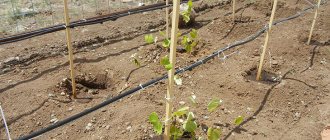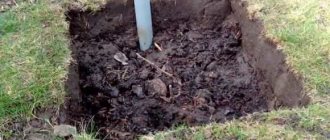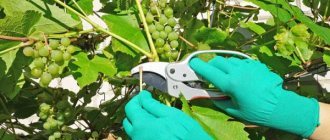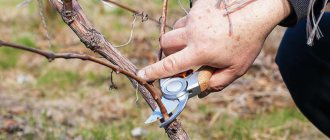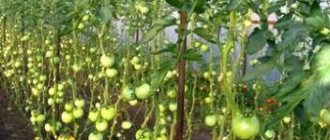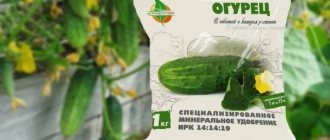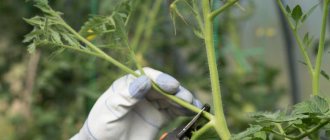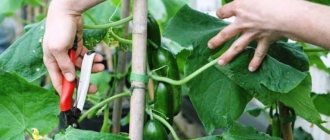Sheltering grapes for the winter is an important agrotechnical measure. Not many novice gardeners know when and how to properly protect a plant from severe frosts. Grapes are a southern, heat-loving plant, so it is necessary to prepare the vine for winter in the proper way. But, among other things, it is necessary to prevent the grapes from drying out, otherwise the owners risk being left not only without a tasty harvest, but also completely without grape bushes. In this article we will tell you how to properly cover grapes for the winter in a polycarbonate greenhouse. To help beginning gardeners - a detailed video.
When to cover grapes?
Severe frosts, which are typical for most of Russia, can destroy not only annual seedlings, but also adult bushes. Without shelter, grapes can tolerate frost down to -15 degrees. A further drop in temperature leads to the death of grape eyes. First of all, annual seedlings are susceptible to this. To prevent such an unfortunate development of events, the gardener must take care of shelter for the plant with the onset of the first cold weather. But shelter alone is not enough; this event still needs to be carried out correctly.
The root system of grapes is very sensitive to low temperatures
Attention! The aboveground parts of the grapes are able to survive low temperatures, but the root system of the plant cannot boast of such frost resistance. Even a slight frost around -5 degrees can damage the fibrous part of the root system, which will ultimately lead to the death of the grapes. If the above-ground part can still be restored in case of frostbite, then in the second case this is impossible.
Of course, you first need to know the temperature regime of the region. If in your area frosts never exceed -16 degrees, then there is no need to worry too much. Frost-resistant varieties can survive harsher frosts. If it is almost impossible to predict the temperature regime of the region, then the best thing to do is to protect the plant from freezing and cover all the grape bushes.
reference Information
The main advantage of growing fruit vines in a greenhouse is the ability to obtain a bountiful harvest in unfavorable weather conditions. The countries of the Mediterranean and the Caucasus, with their warm, mild climate, are considered the homeland of grapes. Plants are not exposed to scorching heat or aggressive cold, so cultivation will not be a problem.
In domestic conditions, growing grapes in a greenhouse is expensive only at the initial stage, when you need to immediately invest in equipment for the premises.
Grapes in a greenhouse give excellent yields and are protected from diseases
Active development of the crop and high yields are ensured even by the most capricious southern varieties. Protected soil will allow you to cultivate fruit vines even in rainy, cool summers.
Read also: Recipes for making cookies at home
Recently, greenhouses have been used not only by large farms, but also by ordinary gardeners. With a reasonable approach, the design can be equipped with a drip irrigation system, which will create a natural habitat for the crop. Ventilating the room and regular treatments will protect the grapes from fungi and insects.
Reeds for shelter must be prepared in advance
The most common methods of shelter
At the first stage, the grape bushes themselves are prepared for wintering, and after that agrotechnical measures are taken to cover the plant. Experienced gardeners recommend using the three most common methods:
- full cover;
- hilling;
- semi-shelter of bushes
It is necessary to cover grapes with natural, “breathable” fabrics
The preparation of grape bushes is as follows:
- First of all, all the bushes are removed from the trellis.
- The vines are being pruned.
- All plant debris is cut off.
- Grape bushes are treated with iron sulfate.
- Abundant watering is carried out.
- If the integrity of the bushes is periodically threatened by rodents, then it is best to place bait under the vine to neutralize the pests
To properly cover grapes, you need to familiarize yourself in detail with the most reliable method.
Covering methods
Connecting the greenhouse to electrical networks will provide the plants with long-lasting warmth. But not all farms need a heated complex year-round, so after harvesting the crop must be covered for the winter. There are several proven methods, which we will tell you about.
Hilling
When growing frost-resistant varieties, it is recommended to carry out the hilling procedure. The soil is carefully loosened around each bush and a mound is poured, the height of which should not be lower than 25 cm.
Remember: soil should not be taken from the base of the grapes, as it may cause the roots to freeze.
Soil must be brought from another place
Plants in a greenhouse are more protected from frost than their outdoor counterparts. But during severe frosts, experienced winegrowers recommend wrapping the trunk with insulating materials and securing it with twine. This “insurance” will ensure a painless winter even for young plantings.
Full Cover
The most effective and safe way to winter in a greenhouse is to completely cover the plant. To do this, the grapes are removed from the trellis, trimmed and twisted into bundles with twine. The bundle is carefully bent to the ground and secured with metal arches. The top of the plants is covered with insulation:
Covering grapes with straw and mats
- old blankets;
- unnecessary blankets;
- reed mats.
Next, everything is tightly covered with film. The structure is buried with a thick layer of soil - at least 30 cm. If the roof of a greenhouse is dismantled for the winter, it is recommended to fix the bushes “under a fur coat” with roofing felt or slate.
Remember: the main enemy of grapes is not frost, but moisture and sudden temperature changes. Therefore, during warm winters, provide the fruit vine with regular ventilation.
Covering with sawdust in a box
Young plantings are protected from frost using car tires. Flexible branches are placed inside the tire, which is problematic with a mature plant. For safe wintering you will need two old tires:
- the first is buried in the ground near the roots;
- the second one from the top is installed.
The entire structure is covered with polyethylene and sprinkled with soil. To protect the structure from the vagaries of nature and excess moisture, it is recommended to install slate or a layer of roofing material on top. It is recommended to make holes in the film for ventilation.
Remember: polyethylene should not come into contact with the kidneys, as moisture provokes decay.
Vertical agrofibre cover
Recently, domestic gardeners often use agrofibre to protect grapes. A special material removes excess condensation from the branches and prevents fungal diseases from developing.
To protect plants from severe frosts, winegrowers use 2-3 layers of agrofibre.
Shelters using wooden boxes are installed in cold climate zones. Such structures will reliably protect grapes from aggressive frosts, but are dangerous in warm winters. If you do not ventilate the vineyard, then excess moisture and heat will cause premature swelling of the buds and become an excellent environment for the development of fungi.
“A properly executed complete cover can reliably protect the plant from the winter cold and save the grape branches from icing. In the event of a warm winter, the gardener will have to perform artificial ventilation, regularly introducing fresh air into the protective structure. Otherwise, a greenhouse may form in it, which will lead to premature bud blooming.”
Preparing grape vines - tying into bunches
Never use manure or humus for insulation. Desperate amateur gardeners cover plants with animal waste products.
Pathogenic bacteria and decaying material are an excellent environment for grapes not to survive until spring.
The most reliable way to cover grapes
The first and most important condition that must be observed with this method is that the grapes must be covered only with material made from natural fabric. At the initial stage, the gardener must remove each bush from the trellis and wait for the leaves to naturally fall off. After which the bush is formed to the required size by pruning. You can use anything as a covering material, even unnecessary old things. But at the same time strictly observe the main rule.
Complete cover of grapevines in a greenhouse
The grapes, covered with natural fabric, are covered with film and pressed to the ground using special brackets, after which they are covered with earth. Depending on the frost, either a small layer or an impressive layer of up to 30 cm is poured.
Attention! Resistant and frost-resistant varieties are often covered simply with slate.
Complete shelter is the method that will one hundred percent protect the grapes from severe frosts. If expectations about severe frosts are not met, then ventilation must be installed in the structure to prevent the grapes from steaming. If there were expectations of a warm winter, but ultimately severe frosts came, then emergency sheltering is carried out - the grapes are pressed to the ground and covered with earth.
Before covering the grapevines, they are treated with copper sulfate
Landing Features
Planting grapes in a greenhouse is not difficult. An indispensable condition is good drainage. If it is not there, you will have to lay additional pipes. It is also important to lay the wire at 20cm intervals.
It will be used as a support. The top wire from the ridge should be at a distance of 40 cm. Exactly the same distance is given from the glass of the greenhouse; if closer, the grapes will get burns. The vine should be planted from the pot at the end of February.
It is useful to combine watering with fertilization
It is recommended to prune at this time.
The landing itself is very simple. First, a hole is dug; its depth should be such that the roots of the plant can freely enter it in a straightened state. Then the hole is filled with soil and watered abundantly.
Sheltering grapes in a greenhouse for the winter
An unheated polycarbonate greenhouse for grapes will also be a kind of protection, but severe frosts can damage the plant. The main problem that a gardener faces when placing bushes in a greenhouse is dense placement in small quantities. During the frostiest time in the greenhouse, experienced winegrowers cover the bushes with simple plastic film, and with the onset of warmth they simply throw it off.
Growing in a greenhouse has a number of advantages, but the main problem that every owner faces is not freezing, but damping off. Even capricious grape varieties feel comfortable under the protective layer of honeycomb carbonate. Grapes often dry out due to the fact that under cover the plant is exposed to high humidity; frost crust has a particularly detrimental effect on the vine. The best solution is to install special end ventilation, which could be opened and closed if necessary. For these purposes, dry leaves are most often used, which are placed in the voids between the covered grapes and the soil.
In a polycarbonate greenhouse, it is not recommended to heavily cover the vines. because they will start to rot away
Winter is not scary
Tools: what gardening tools might be useful?
I don’t lay the bushes on the ground, so I grow grapes on a low trunk. In the fall, I put the greenhouse and plants in order (I prune, wash the vine with a strong solution of potassium permanganate, and after a couple of days I “hill” it with soil mixture). I bend and tie the shoots and cover the greenhouse with non-woven material on top. At its ends (from the first and last arc), the edges of the non-woven fabric must be lowered to the ground so that cold air does not penetrate inside in winter. In frosty winters, I also put a thick plastic film on top. If the weather does not make its own adjustments, then at the end of February - at the beginning of March I remove the polyethylene, and in March-April - Lutrasil. Sometimes I open the windows slightly even on winter days - this eliminates dangerous air humidity, and therefore many grape diseases.
Maria Anashina,
aif.ru
Mistakes to Avoid While Covering
Beginning gardeners are more susceptible to making plant-damaging mistakes. To avoid unpleasant consequences, you must consider the following:
- do not put too much soil on the film;
- do not use soil that was in close proximity to the grape bushes for covering;
- carefully consider ventilation for the plant, which will save you from many troubles.
Proper sheltering of grapes in a greenhouse will protect the plant from freezing and drying out, and ultimately allow the owners to enjoy a tasty harvest.
The enemy will not pass
Constant monitoring of the condition of grapes allows you to avoid outbreaks of diseases and not to use those poisons, the use of which is inevitable in open ground. For example, the scourge of some varieties - moldy cracks on the skin of ripe berries - is easier to localize in a greenhouse by simply removing individual cracked berries. Last summer was rainy, but the skins burst only on Agat Donskoy and Victoria , although familiar amateur winegrowers complained about many varieties that were “bursting at the seams.”
Grapes in a greenhouse - photo
Things to remember
In order for the grapes to successfully survive the winter in the greenhouse, you need to first prepare the fruit vine. A strong plant with an excellent supply of nutrients will easily survive the vagaries of nature. Therefore, be sure to worry about regular feeding.
It is necessary to harvest the crop in advance for the vine to ripen.
Remember: the longer the fruits hang on the branches, the less time the bush has to reserve useful elements for future use.
It is recommended to apply potassium fertilizers in the winter, which accelerate the ripening of young shoots. Nitrogen-containing substances activate foliage growth, which slows down the preparation of the bush for wintering. After harvesting, the plants are fed:
- potassium magnesia;
- wood ash;
- potassium sulfate.
To ensure that substances are absorbed faster, experienced gardeners spray fertilizer on the leaves. The concentration of the drug is reduced by half, but the frequency of treatments is increased to 1 time every 7 days.
Remember: the procedure is carried out in the morning or evening so that the chemicals in the sun do not burn the foliage.
Yield rationing also ensures rapid ripening of young shoots. The optimal number of bunches will not deplete the bush and will not make the vine too “overfed”, which also negatively affects the survival of the plant in winter. A mature branch is straw-brown in color and makes a slight cracking sound when bent, but does not break.
Preparing the vine - pre-pruning
Autumn pruning is not a whim of gardeners, but a necessary preventive procedure. Sick and immature vines do not survive wintering conditions, so they become a breeding ground for diseases and infections. After the plant has shed its leaves, the winegrowers begin a thorough inspection and rejection of the branches.
Professionals recommend carrying out the operation after the first frost, as early action will weaken the fruit vine.
Remember: you cannot prune or pick greens immediately after harvesting. The plant has spent energy and nutrients on the fruits, so it needs time to replenish its reserves for the winter.
Preventive treatments with fungicides will protect grapes from pathogenic fungi and infections. Even if your greenhouse has not been affected by mildew or oidium this season, spraying it with Bordeaux mixture or copper sulfate for the winter should not be skipped.
Rodents and insects will also not allow the fruit vine to overwinter peacefully. Therefore, it is recommended to worry about preventive treatments in advance.
Circular laying of vines saves space
“If the grapes were sick, then after harvesting, when there is no longer any danger of eating fruits treated with fungicides, it’s time to treat with some systemic fungicide in a therapeutic (one-and-a-half or double) concentration. This will significantly suppress the pathogen and enable the vines to ripen better and approach winter relatively healthy.”
Wintering in a greenhouse requires regular ventilation of the premises. Condensation is deadly to grapes.
The higher the air humidity, the more dangerous the environment for the crop. Why is this happening? When at rest, the plant does not absorb water, so any moisture leads to rot and disease. Sharp frosts will kill the buds and roots.
Read also: Craft ideas for kindergarten on the theme of autumn
We figured out how to cover grapes for the winter in a greenhouse. Using our recommendations, you will preserve the capricious fruit vine under unfavorable climatic conditions and protect it from fungi and diseases.
Sheltering grapes for the winter is an important agrotechnical measure. Not many novice gardeners know when and how to properly protect a plant from severe frosts. Grapes are a southern, heat-loving plant, so it is necessary to prepare the vine for winter in the proper way. But, among other things, it is necessary to prevent the grapes from drying out, otherwise the owners risk being left not only without a tasty harvest, but also completely without grape bushes. In this article we will tell you how to properly cover grapes for the winter in a polycarbonate greenhouse. To help beginning gardeners - a detailed video.
History and modernity
Before the construction of railways (in the middle of the 19th century), potted grape cultivation in protected soil was widespread. If you look at “The Complete Russian Experienced Gardener” by Ivan Tsigra (mid-19th century), you will find out that, for example, in St. Petersburg the most popular variety was Krupny Astrakhansky, which was cultivated in large quantities. The vine was led into two stems, distributed on two sides. The shoots were pruned short, every year by 2–3 eyes before fruiting began. At the beginning of fruiting, if the buds were poorly developed, cut off to 4–6 eyes. Pruning was the same for all vines grown in greenhouses, tubs and boxes.
Nowadays, greenhouses with polycarbonate coating are very promising for growing grapes. If the greenhouse is directly connected to the house, it becomes a winter garden. The greenhouse is economical due to the use of accumulated heat from the walls, reducing the cooling of the house and heating costs. The earliest grape harvest is harvested in such greenhouses. The vines are not covered for the winter.
We protect cover and greenhouse grapes from diseases.
From the budding phase, we begin preventive spraying with low-toxic drugs: “Lugol” (potassium iodide) – 0.02%, baking soda – 0.8%, potassium permanganate – 0.3%. You can add to the sprayer all the necessary fertilizers and microelements that strengthen the immunity of plants, and there, in the general solution, means against diseases and pests.
If the vine is formed correctly, among the growing shoots there will definitely be fruitful ones. They are easily identified by the primordia (“eggs”) of inflorescences in the lower part of the shoot. Unfruitful shoots are removed in a non-lignified state. If there are no fruitful shoots, then the variety is not suitable for growing in your conditions. It is believed that varieties with dark-colored berries require more heat to ripen compared to white-fruited ones; perhaps this information will serve as a guide when choosing varieties.
The varieties are worth trying.
Muscat of Alexandria . _ The berries are amber and delicious. They require additional warmth to ripen in late summer.
Buckland Sweetwater . _ _ _ The berries are amber, large. The vine is compact.
Perlette . _ The berries are green, sweet, without seeds. Early ripening variety.
Schiava Grossa , Black Hamburgh . _ _ _ The berries are black, large, sweet, collected in large clusters. Reliable variety. Grapes of the Schiava Grossa variety in the greenhouse bring abundant harvests.
